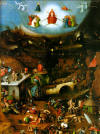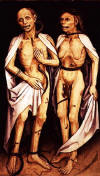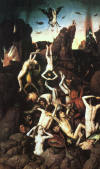Search:: Artists Alphabetically Artists by Country Artists by Century Artists by Movement
BLACK DEATH
How the Plague Changed Art History

 The
plague fist showed up in Italy in the late 1340s and returned with
regular outbreaks for the next five hundred years. Many of
Italy's greatest painters died of plague, including the great
Sienese geniuses, Ambrogio Lorenzetti and Pietro Lorenzetti, who died in the first out break of 1348. Later plague epidemics took the lives of Andrea del Sarto, Titian, Dosso Dossi, and the greatest Venetian genius of all time, Giorgione .
The horrors of the black death pervaded all aspects of European
culture, especially art. The effects were lasting, bringing a
somber darkness to visual art, literature, and music. The dreadful
trauma of this era instigated the imaginations of writers and painters
in bleak and disturbing ways for decades to follow. Hell, Satan and the
Grim Reaper became favored subjects. When
the plague first struck, Europe was emerging from the "dark ages"
trying to put unpleasant memories behind it and move on to a more
enlightened era. Barbarians no longer ran rough shod, putting entire
villages to the torch and slaughtering the local peasants.
Without the constant fear of invasion, art and architecture found
fertile ground to grow. Gothic painters were not simply anonymous lowly
craftsmen, but well respected professionals. They were held in high
esteem and often interacted with clergy and wealthy patrons. The
arrival of Black death harkened in a new darker era of painting.
Paintings were overflowing with tortured souls, death, dying, fire and
brimstone.
The
plague fist showed up in Italy in the late 1340s and returned with
regular outbreaks for the next five hundred years. Many of
Italy's greatest painters died of plague, including the great
Sienese geniuses, Ambrogio Lorenzetti and Pietro Lorenzetti, who died in the first out break of 1348. Later plague epidemics took the lives of Andrea del Sarto, Titian, Dosso Dossi, and the greatest Venetian genius of all time, Giorgione .
The horrors of the black death pervaded all aspects of European
culture, especially art. The effects were lasting, bringing a
somber darkness to visual art, literature, and music. The dreadful
trauma of this era instigated the imaginations of writers and painters
in bleak and disturbing ways for decades to follow. Hell, Satan and the
Grim Reaper became favored subjects. When
the plague first struck, Europe was emerging from the "dark ages"
trying to put unpleasant memories behind it and move on to a more
enlightened era. Barbarians no longer ran rough shod, putting entire
villages to the torch and slaughtering the local peasants.
Without the constant fear of invasion, art and architecture found
fertile ground to grow. Gothic painters were not simply anonymous lowly
craftsmen, but well respected professionals. They were held in high
esteem and often interacted with clergy and wealthy patrons. The
arrival of Black death harkened in a new darker era of painting.
Paintings were overflowing with tortured souls, death, dying, fire and
brimstone.
Bubonic Plague was known as the Black Death and had been known in Europe for centuries. It was a grisly sickness. The victim's skin turned purplish in places and inflamed pustules burst open spilling contagious puss on bystanders. To top it off victims also endured compulsive projectile vomiting. This caused clergy to denounce early victims as being possessed by the devil.
After a few days or even hours plague victims became unrecognizable, grotesque monsters. The died by the millions, alone in agony, their kinsmen fleeing in terror. Government and Clergy tried to control the catastrophe, but the disease progressed relentlessly, eventually wiping out 80 million people.
Traveling in the Middle Ages was discouraged by feudal lords. Peasants were often considered the property of their overlords. Non-Christians had a particularly difficult time traveling about in Medieval Europe. According to distinguished historian Israel Abrahams, "Before leaving home, a Jewish wayfarer of the Middle Ages was bound to procure two kinds of passport. In no country in those days was freedom of motion allowed to anyone. The Jew was simply a little more hampered than others. In England, the Jew paid a feudal fine before he might cross the seas. In Spain, the system of exactions was very complete. No Jew could change his residence without a license even within his own town. But in addition to the inflictions of the Government, the Jews enacted voluntary laws of their own, forcing their brethren to obtain a congregational permit before starting."
A Medieval Song about the Plague
"A sickly season," the merchant said,
"The town I left was filled with dead,
and everywhere these queer red flies
crawled upon the corpses' eyes,
eating them away."
"Fair make you sick," the merchant said,
"They crawled upon the wine and bread.
Pale priests with oil and books,
bulging eyes and crazy looks,
dropping like the flies."
"I had to laugh," the merchant said,
"The doctors purged, and dosed, and bled;
"And proved through solemn disputation
"The cause lay in some constellation.
"Then they began to die."
"First they sneezed," the merchant said,
"And then they turned the brightest red,
Begged for water, then fell back.
With bulging eyes and face turned black,
they waited for the flies."
"I came away," the merchant said,
"You can't do business with the dead.
"So I've come here to ply my trade.
"You'll find this to be a fine brocade..."
And then he sneezed.
Require
more information about The Consequences of Black Death on Art and
Artists in the Medieval Period in Art History? Type your query in art
into the google search box below and poke around every nook and cranny
of the known universe for information this subject. Search Here
Symbolism
Do you know something we don't? If you have comment or would like to share an insight regarding The Effect of Black Death on Art and Artists in the Medieval Period in Art History, please submit your comment to the editor, via e-mail and if possible site the source. Thank you!
© HistoryofPainters.com If you like this page and wish to share it, you are welcome to link to it, with our thanks.
copyright 2017 - historyofpainters.com
The Meaning of Sacred Symbols in Paintings. Most prominently featured symbols and their meaning:
- The Serpent
- Good Shepherd
- Key
- Wheat
- Virgin Mary
- Christ
- The Anchor
- The Apostles
- Satan
- Chalice
- The Cross
- Fruit
- The Saints
- Colors
- Book
- Birds
- Angels
- Insects
- Fish
- Spider
- Animals
- Household Objects
iconography
100 greatest paintings
illuminated manuscripts
artist biographies
medieval art
renaissance art
rococo art
Blackdeath
classical
Expressionist
Entartete Kunst